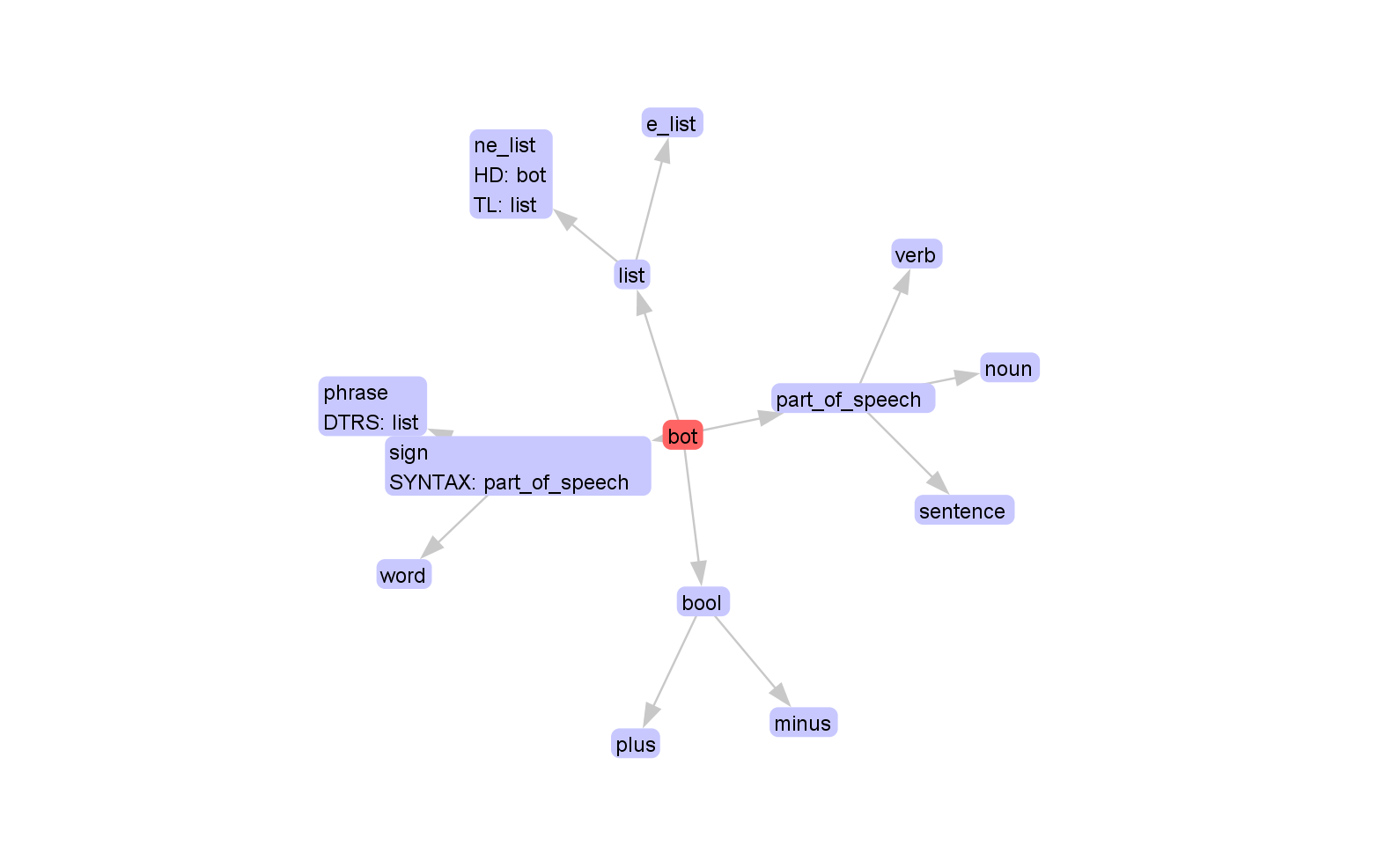Grammar Writing: Week 4: Difference between revisions
Jump to navigation
Jump to search
Nikoschenk (talk | contribs) No edit summary |
|||
| (2 intermediate revisions by 2 users not shown) | |||
| Line 1: | Line 1: | ||
== | == Motivation == | ||
Implement your first grammar including | |||
-- i.) a type hiararchy, | |||
-- ii.) lexical entries (words), and | |||
-- iii.) three syntactic rules to properly combine words. | |||
---- | |||
( | == Homework Assignment (Due November 5th) == | ||
<span style="color: blue>Task 1</span> | |||
In DesktopTrale, model the following type hierarchy. Make sure to start with topmost types. Add features only after the corresponding types have been specified. | |||
Don't forget to finally update the type hierarchy to make the changes effective. '''No spaces, no upper case letters, only underscore characters are allowed !''' | |||
[[File:Svnplaygroundth.png|center|The "02_SNV" type hierarchy]] | |||
<span style="color: blue>Task 2</span> | |||
Save the Type Hierarchy both in XML and in Trale format under the name "02_SVN". | |||
= | <span style="color: blue>Task 3</span> | ||
Add lexical entries for "Lilly", "John", "cigarettes", "books", "reads", "cars", "smokes", "drives", "gives", and "dances". (Use lowercase letters also for the proper names!) | |||
a. Add | <span style="color: blue>Task 4</span> | ||
* Add a rule called "verb_noun_rule" with two child nodes, which combines a verb followed by a noun to form a sentence node. (e.g., for "smokes cigarettes"). | |||
* Add a rule called "noun_verb_rule" with two child nodes, which combines a noun followed by a verb to form a sentence node. (e.g., for "John smokes.") | |||
* Add a rule called "verb_noun_noun_rule" with three child nodes, which combines a verb followed by two nouns to form a sentence node and '''provide an example''' for a phrase which could be recognized from the list of available lexical entries. | |||
Note: Tags (boxed numbers representing child nodes) should be moved into the ''daughters'' list (DTRS) of the parent node. This can be accomplished by drag-and-drop (left click on the tag and move it inbetween the brackets), OR by keeping CTRL/(STRG) pressed + right click on the DTRS list and then selecting ''Add Tag to list''. | |||
<span style="color: blue>Task 5</span> | |||
Save the grammar as XML and Trale under the name "02_SVN_ready_for_testing". | |||
| Line 56: | Line 40: | ||
Navigation: | Navigation: | ||
<div align="center"> | <div align="center"> | ||
[[Grammar_Writing|'''Main Page''']] [[Grammar_Writing:_Week_2| '''Week 2''']] [[Grammar_Writing:_Week_3| '''Week 3''']] '''Week 4''' [[Grammar_Writing:_Week_5| '''Week 5''']] [[Grammar_Writing:_Week_6| '''Week 6''']] | [[Grammar_Writing|'''Main Page''']] [[Grammar_Writing:_Week_2| '''Week 2''']] [[Grammar_Writing:_Week_3| '''Week 3''']] '''Week 4''' [[Grammar_Writing:_Week_5| '''Week 5''']] [[Grammar_Writing:_Week_6| '''Week 6''']] [[Grammar_Writing:_Week_7| '''Week 7''']] [[Grammar_Writing:_Week_8| '''Week 8''']] [[Grammar_Writing:_Week_9| '''Week 9''']] | ||
</div> | </div> | ||
Latest revision as of 15:34, 31 October 2018
Motivation
Implement your first grammar including
-- i.) a type hiararchy, -- ii.) lexical entries (words), and -- iii.) three syntactic rules to properly combine words.
Homework Assignment (Due November 5th)
Task 1
In DesktopTrale, model the following type hierarchy. Make sure to start with topmost types. Add features only after the corresponding types have been specified.
Don't forget to finally update the type hierarchy to make the changes effective. No spaces, no upper case letters, only underscore characters are allowed !
Task 2
Save the Type Hierarchy both in XML and in Trale format under the name "02_SVN".
Task 3
Add lexical entries for "Lilly", "John", "cigarettes", "books", "reads", "cars", "smokes", "drives", "gives", and "dances". (Use lowercase letters also for the proper names!)
Task 4
* Add a rule called "verb_noun_rule" with two child nodes, which combines a verb followed by a noun to form a sentence node. (e.g., for "smokes cigarettes").
* Add a rule called "noun_verb_rule" with two child nodes, which combines a noun followed by a verb to form a sentence node. (e.g., for "John smokes.")
* Add a rule called "verb_noun_noun_rule" with three child nodes, which combines a verb followed by two nouns to form a sentence node and provide an example for a phrase which could be recognized from the list of available lexical entries.
Note: Tags (boxed numbers representing child nodes) should be moved into the daughters list (DTRS) of the parent node. This can be accomplished by drag-and-drop (left click on the tag and move it inbetween the brackets), OR by keeping CTRL/(STRG) pressed + right click on the DTRS list and then selecting Add Tag to list.
Task 5
Save the grammar as XML and Trale under the name "02_SVN_ready_for_testing".
Navigation:
